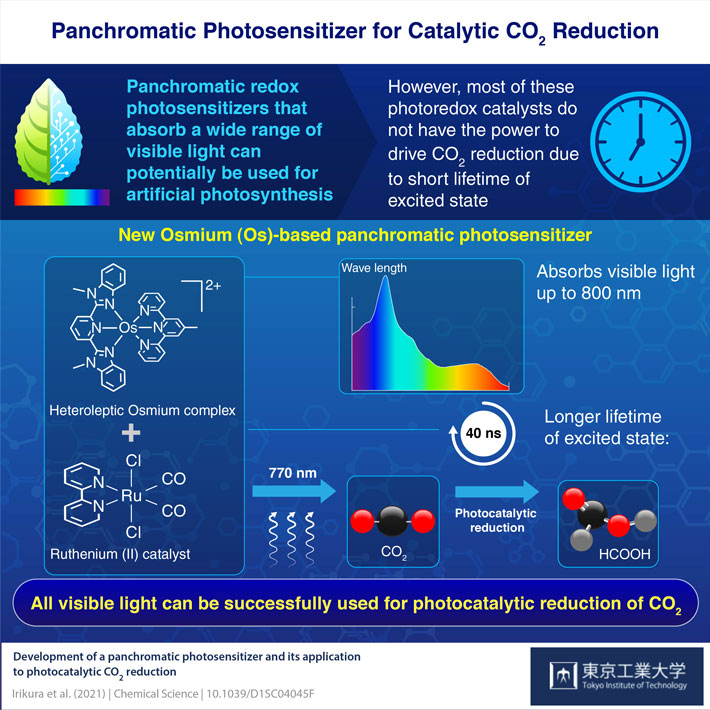Using photocatalysts to reduce CO2 has received a lot of attention recently. Scientists from Tokyo Tech have developed a new osmium complex that can absorb a full wavelength range of visible light and act as a panchromatic redox photosensitizer for CO2 reduction. The team combined this complex with a ruthenium (II) catalyst and successfully reduced CO2 into formic acid.

Finding solutions for the current climate and energy crisis has become a common goal across the globe. And why look far when we have the perfect solution right around us? Taking a page out of nature's book, scientists have been trying to recreate the process of photosynthesis to combat climate change. Beyond helping plants prepare their food, photosynthesis also makes them one of the major carbon sinks that trap carbon dioxide (CO2) from the atmosphere and convert it to other forms. This makes artificial photosynthesis a lucrative method for not just hydrogen evolution and water oxidation but also CO2 reduction.
The two major components required to initiate the multi-electron process of CO2 reduction are a redox photosensitizer that can absorb visible light and initiate electron transfer, and a catalyst that can accept the electrons from the redox photosensitizer, activate CO2, and finally introduce these electrons into CO2. To best utilize solar energy, the photosensitizer must be sensitive over a wide range of light wavelengths. Accordingly, panchromatic redox photosensitizers, materials that absorb the full wavelength of visible light, are the way to go.
Ruthenium (Ru) complexes are commonly used redox photosensitizers that absorb light and reach "excited" states via the process of metal-to-ligand charge transfer. However, they cannot use low energy parts of visible light because they cannot absorb this light. Most reported panchromatic complexes cannot also be used for photoredox reactions because the lifetimes of their excited states are too short.
In a recent study published in Chemical Science, researchers from Tokyo Institute of Technology (Tokyo Tech) led by Dr. Yusuke Tamaki and Prof. Osamu Ishitani adopted a new strategy to improve the photoredox properties of panchromatic photosensitizers. The team developed a new osmium (Os) complex that could absorb the full wavelength range of visible light. Using this complex as the redox photosensitizer and a ruthenium complex catalyst (Ru(CO)), they developed a photocatalytic system that could reduce CO2 into HCOOH (formic acid). Prof. Ishitani explains, "We were on the lookout for photocatalytic systems that allowed effective utilization of the solar light to carry out artificial photosynthesis. This is when we focused our attention to the photochemical properties of Os complexes, which rise from the heavy atom effect of Os. Since the photophysical, photochemical and photosensitizing properties of Os complexes were not explored, we decided to test its abilities in CO2 reduction."
The UV-visible absorption spectrum showed that the Os complex absorbed visible wavelengths up to 800 nm, i.e., even red light. The complex exhibited a relatively long excited-state lifetime of 40 ns, sufficient for initiating electron-transfer processes required for reduction. To carry out the photochemical reduction experiments, the team irradiated the combined Os photosensitizer and Ru(CO) with 770 nm light. The system photocatalytically reduced CO2 into formic acid with good reaction turnover numbers.
This study can be expanded by using the panchromatic Os photosensitizer to carry out other various useful photochemical reactions such as H2 evolution from water and organic photoredox reactions. "The implications of our study are two-fold. Firstly, we demonstrated that all visible light can be used as energy for photocatalytic CO2 reduction. Secondly, we used the heavy atom effect to construct new redox photosensitizers that can absorb a wide range of visible light." concludes Prof. Ishitani.
This research is published in Chemical Science, the Royal Society of Chemistry's peer-reviewed flagship journal, and is free to read this article.
Reference
Authors : |
Mari Irikura, Yusuke Tamaki, Osamu Ishitani |
Title of original paper : |
Development of a panchromatic photosensitizer and its application to photocatalytic CO2 reduction |
Journal : |
Chemical Science |
DOI : |
|
Affiliations : |
Department of Chemistry, School of Science, Tokyo Institute of Technology |






